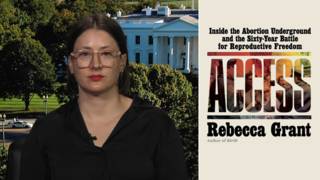
Guests
- Linda Villarosadirector of the journalism program at the City College of New York and a contributing writer for The New York Times Magazine.
Tuesday marked the end of the inaugural Black Maternal Health Week, a campaign founded and led by the Black Mamas Matter Alliance. The effort was launched to build awareness and activism around the state of black maternal health in the U.S. The United States ranks 32 out of the 35 wealthiest nations in infant mortality. Black infants are now more than twice as likely to die as white infants, a disparity greater than existed in 1850, 15 years before slavery ended. Each year, an estimated 700 to 900 maternal deaths occur in the U.S., which is one of only 13 countries in the world where the rate of maternal mortality is worse than it was 25 years ago. And according to the Centers for Disease Control, black women are three to four times as likely to die from pregnancy-related causes as their white counterparts. These statistics were reported in a powerful new investigation in The New York Times Magazine, “Why America’s Black Mothers and Babies Are in a Life-or-Death Crisis.” Even more shocking is that, according to the report and contrary to widely accepted research, education and income offer little protection. The answer to the disparity in death rates has everything to do with the lived experience of being a black woman in America. We speak to New York Times Magazine contributing writer Linda Villarosa, who directs the journalism program at the City College of New York.
Transcript
NERMEEN SHAIKH: Tuesday marked the end of the inaugural Black Maternal Health Week, a campaign founded and led by the Black Mamas Matter Alliance. The effort was launched to build awareness and activism around the state of black maternal health in the U.S.
Here are a few sobering statistics that underscore the need for such a campaign. The United States ranks 32nd out of the 35 wealthiest nations in infant mortality. Black infants are now more than twice as likely to die as white infants, a disparity greater than existed in 1850, 15 years before slavery ended. Each year, an estimated 700 to 900 maternal deaths occur in the U.S., which is one of only 13 countries in the world where the rate of maternal mortality is worse than it was 25 years ago. And according to the Centers for Disease Control, black women are three to four times as likely to die from pregnancy-related causes as their white counterparts.
AMY GOODMAN: Black women and babies make up a significant number of the cases of infant and maternal mortality in the United States. These statistics were reported in a powerful new investigation in The New York Times Magazine called “Why America’s Black Mothers and Babies Are in a Life-or-Death Crisis.” Even more shocking is that, according to the report and contrary to widely accepted research, education and income offer little protection. The answer to the disparity in death rates has everything to do with the lived experience of being a black woman in America, says our guest, journalist and New York Times Magazine contributing writer Linda Villarosa. She directs the journalism program at the City College of New York.
Welcome to Democracy Now! It’s great to have you with us.
LINDA VILLAROSA: Thank you. Thank you so much.
AMY GOODMAN: A really powerful piece. Why are America’s black mothers and babies in a life-or-death situation today?
LINDA VILLAROSA: Well, when you go through the research—and I’m very interested in data and research—first you have to look at all the things that it is not. So, you start to think, “Well, is it because black women are not taking care of themselves?” But then there’s studies that say, “Oh, even when prenatal care is the same, then still black women have low-birthweight babies.” Then it’s sort of like, “Well, is there some kind of gene? Is there a genetic component?” Then there are studies that say, “No, actually, because when African immigrants and Caribbean immigrants come here, their babies are equal to white babies in size. But after a generation, then they start to look like African-American babies, even when they’re from the poorest countries.” And so, after a while, it starts to just say, “Well, actually there is something else going on, that has to do with being a black woman in America.”
AMY GOODMAN: Talk about what it is.
LINDA VILLAROSA: It is race and racism. So, it’s in two ways. One is just the lived experience of what happens to black women in the country has a physiological effect. And there’s a wonderful researcher in the University of Michigan who coined the term “weathering.” And so, I think I love the term, because it’s very poetic. So it says it’s like the weathering of a rock by the ocean. But it’s also like the weathering—weathering a storm, by a house, because it also speaks to resilience and resistance.
But it is—there is a physiological effect. So, if you are stressed out—and I don’t mean, “Oh, I’m so stressed out,” the “lean in” kind of stressed out, but repeated insults to your psyche, over and over and over again—it revs up your system so that it actually starts to wear you down, the internal systems of your body. So that’s part one of this, is the lived experience of being a black woman in America.
The second is the way black women are treated in the healthcare system. And I say black women, but I mean black people. And this has been studied ad nauseam. I’ve read so many studies, my eyeballs want to fall out. But it’s hard to get this across. And a lot of people will say, “Oh, the Tuskegee experiment. That’s what it’s about.” And I say, “The Tuskegee experiment was years ago. We’re talking about people who are being mistreated, ill-treated right now.”
And so, if you combine the two, and you take a woman who is essentially having a stress test to her body, which is pregnancy and childbirth, and you put her in this volatile situation where she’s weathered and worn down by repeated insults, and then she’s in a system that maybe isn’t out for her best interest, you get a volatile mix.
NERMEEN SHAIKH: And that would explain why neither education nor income substantially impacts maternal health.
LINDA VILLAROSA: I think what really explains it is—what really puts it into stark focus is what happened to Serena Williams. So, Serena Williams had her baby in September. And after the baby was born, she started complaining about having shortness of breath. She had a history of pulmonary embolisms, which is a blood clot in the lungs. So, she was ignored, and her concerns weren’t taken seriously, and it led to a crisis. Presumably, this is one of the richest women in the world and one of the most proactive and one of the most powerful. But still, her legitimate concerns were ignored at a hospital.
AMY GOODMAN: And she told the nurse exactly what she needed. She knew what she had. She said she needed a CT scan with contrast and IV heparin, a blood thinner, right away. The nurse thought her pain medicine might be making her confused. She insisted. Soon enough, a doctor was performing an ultrasound on her legs. And, I mean, you have the ultrasound revealing nothing, so they sent for a CT. Sure enough, several small blood clots had settled in her lungs. She was right. Minutes later, she had the drip. And she said, “I was like, 'Listen to Dr. Williams.'”
LINDA VILLAROSA: Yes, please, the owner of your own body, that you know best.
NERMEEN SHAIKH: Well, in your piece, you also talk about your own experience. So, could you tell us what happened in your case?
LINDA VILLAROSA: Well, what was interesting for me is I had read a study about college-educated women who have more—the higher rate of infant mortality, 75 percent related to low birth weight. So I’m thinking, “OK.” I didn’t believe it at first, because I was still under the assumption that this was strictly a problem of poor women, which is wrong and terrible, but I still thought, “Well, OK, I see this.”
But then, when I got pregnant, I ended up—my baby was not progressing, was not large enough, given her gestational age. So my wonderful gynecologist said, “You need to go on bed rest. and you need to go to a specialist.” So I went to the specialist, and the specialist was grilling me with all kinds of, “Do you use cocaine? Do you drink? Do you…?” And I’m the health editor of Essence magazine, so I am super into health. I’m very into fitness. I am trying to be a role model for good health, and take care myself and my baby. So I was really insulted. “Do you have all these different kinds of illnesses?” I’m like, “No, I’m fine.”
And then I looked up what I had, called intrauterine growth restriction, and it is something that is associated with women who are not taking care of themselves, smoking, drinking, using drugs, or ill. And so, I thought, “What is wrong with me?” It turned out my baby was better not inside of me but on the outside, so I had her induced right at term. She was low birth weight. Low birth weight is 5.5 pounds. She was four pounds, 13 ounces. She is fine now. She’s a healthy, smart, athletic college student.
AMY GOODMAN: We have 10 seconds.
LINDA VILLAROSA: But I thought, “Is this because of my lived experience of being a black woman in America?”
AMY GOODMAN: We’re going to do Part 2 of this discussion, and we’re going to post it online at democracynow.org. Linda Villarosa directs the journalism program at City College of New York, contributing writer for The New York Times Magazine. We’ll link to her piece, “Why America’s Black Mothers and Babies Are in a Life-or-Death Crisis.”












Media Options